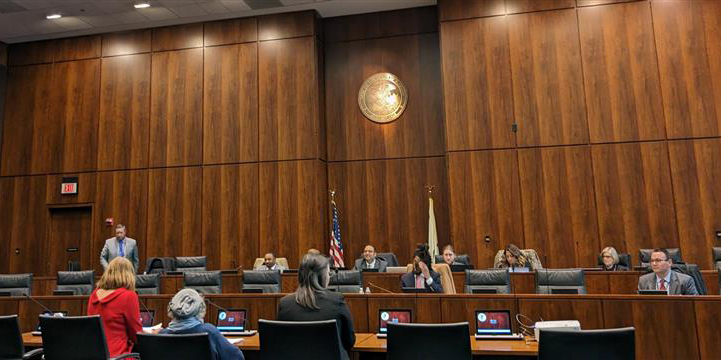At a recent hearing held by the Illinois Senate, the Active Transportation Alliance and other advocates urged lawmakers to step up with needed support for a host of transit problems, including a looming funding cliff and the need for better governance for the transit agencies.
“The impending transit funding cliff forces us to ask hard questions about the structure of our future transit system,” said Audrey Wennink, senior director of transportation at Metropolitan Planning Council, in her testimony at the hearing. “In the next year legislators are going to be asked to make some important and tough decisions. Now is the time to be preparing for that.”
During the hearing, Illinois Senate committee members heard from the leaders of the local transit agencies, leaders from local labor and business organizations, and representatives from local advocacy and planning organizations.
Dorval Carter, president of the CTA, was the only transit agency leader not in attendance.
Before the hearing, Active Transportation Alliance teamed up with Commuters Take Action and Access Living to hold a press conference to shine a spotlight on how the state needs to get serious about supporting public transit during a time of great need.
The press conference was intended to reinforce the sentiments conveyed by advocates in the hearing — that lawmakers must look for bold solutions to address this enormous budget shortfall and a host of chronic transit issues.

DAY-TO-DAY RELIABILITY PROBLEMS
As most transit riders in Chicago know, our transit system has serious reliability problems. There is little transparency and accountability from the CTA and making matters worse is a faulty bus and train tracking system.
Another challenge facing the system is the CTA’s difficulty in hiring people to fill hundreds of vacant positions.
The effects of unreliable and poor service and staffing issues are being disproportionately felt by the Black and Brown riders who are the core users of the transit system.
“Since the onset of the pandemic, the Chicago Transit Authority’s service has deteriorated significantly and thousands of commuters are victims to ghost buses and late rides every day,” said Morgan Madderom, an organizer with Commuters Take Action (speaking in the photo above). “We are sympathetic to CTA’s struggles to find bus and train operators, but the agency needs to inform their riders better about how much their essential transportation has been affected.”
All these shortcomings would be compounded exponentially if the funding cliff is not addressed.

THE IMPENDING FUNDING CLIFF
According to the Regional Transportation Authority, the transit agencies are expecting a $730 million shortfall, which represents roughly 20 percent of the annual transit budget. This funding gap could require drastically cutting back service and needed improvements for CTA, Metra, and Pace starting in 2026.
Jacky Grimshaw, vice president of government affairs at the Center for Neighborhood Technology, said during her testimony that a 20 percent operating budget gap cannot be addressed simply by cutting 20 percent of service.
“Transit systems inherently have many fixed operating costs beyond just running a bus or a train, such as maintaining stations and garages,” she said. “It might require a 30-40 percent service cut to reduce operating costs by 20 percent. Service cuts of that magnitude would lead to a vicious cycle: Cuts would lower ridership; lower ridership would mean less fare revenue, which, in turn, would require additional cuts to address the growing budget gap.”
RETHINKING GOVERNANCE STRUCTURE
Amber Smock, director of advocacy at Access Living, said during our press conference that the State of Illinois must modernize how the state supports governance and funding of public transportation. “We are eager to work with the legislature to advance crucial action on transit system funding, governance, coordinated regional service, and other factors,” she said.
Over the past 40 years, Wennink said the governance structure for transit in Northeast Illinois has not changed, but our mobility needs have.
She urged the committee to take a closer look at the four separate boards overseeing four different transit agencies in Northeast Illinois: “Who is appointing these boards? What overlap is there? Does this support good regional decision making and service coordination? What other models are out there that we should consider?”
“Now is the time to double down on developing a vision for the future of transit in a post-COVID world,” she said. “We know we need to fix the problems of today while also addressing the problems of tomorrow.”
Bottom photo shows the Illinois Senate hearing on transit.

